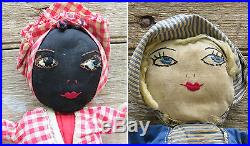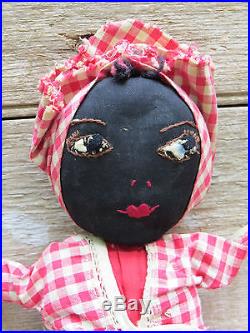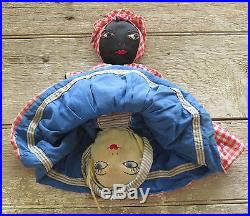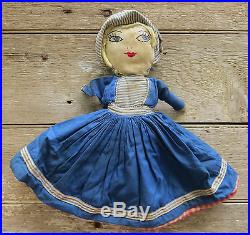Primitive Original Topsy Turvy Rag Doll Handmade Cloth Folk Art Plantation Toy













This excellent, Original Topsy-Turvy Rag Doll has hand-stitched facial features and significant remnants of yarn hair on both signs. Black side of doll with felt eyes is wearing a red and white homespun gingham dress with matching headwrap. White side has hand stitched eyes, a blue cotton and seersucker sailor style dress with a seersucker bonnet. Evidently well loved doll has some wear to felt eyes on her black side and head wrap is loose at the top One hand is missing and both sides have some minor soil.
Heads are secure but loose with hand stitching visible in spots. Primitive Doll is 12 1/2" High with a 15" base width Fantastic, historic doll has loads of character and will make a fabulous addition to any collection. Read more about the history of "Topsy Turvy" dolls From Historical Folk Toys. Historical Background: Considered a controversial doll by some, the authentic Topsy-Turvy doll, features a black doll with a headscarf on one end and a white doll with an antebellum-style dress on the other end. The black doll could represent a maid, slave or servant and the white doll could represent the master's child or the mistress of the house.The original Topsy-Turvy dolls were created before the Civil War in the Southern United States on plantations where slavery was prominent. Arguments arise as to whether the dolls were made for the slave children to play with or whether they were made for the white children who lived in the plantation house.
Topsy-Turvy Doll Positioned for Black Doll With one identity on one side and an opposite identity when flipped, slave children could have played with their prohibited black doll and then flipped it to the white doll when the master was around. Others believe that the double-ended dolls were made for white children with the black doll used as a maid for their other dolls. Siek writes that this doll was a mirror of the African-American woman's life. She took care of white children, but had children of her own -- the white child is present when the black child is invisible, the black child is present when the white child is invisible.
Kimberly Wallace-Sanders has explored the possibility that Topsy-Turvy dolls were made by the black mammies to represent the two categories of children they took care of: the white master's children verses their own. After the Civil War, the white side of the doll was identified as that of a child, while the black doll suggested the black mammy caretaker. Black and White Topsy-Turvy dolls began to be mass manufactured after 1900. The Babyland Rag company produced a Topsy-Turvy doll with a hand painted face in 1901. Later, wooden Topsy-Turvy dolls were made with jointed arm.
The item "Primitive Original Topsy Turvy Rag Doll Handmade Cloth Folk Art Plantation Toy" is in sale since Sunday, July 05, 2015. This item is in the category "Collectibles\Cultures & Ethnicities\Black Americana\Dolls & Bears". The seller is "savingshepherd" and is located in Felton, Pennsylvania. This item can be shipped worldwide.
